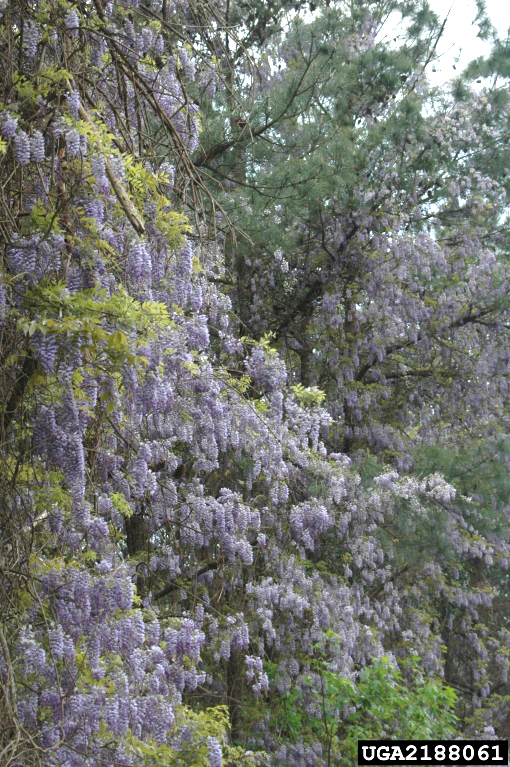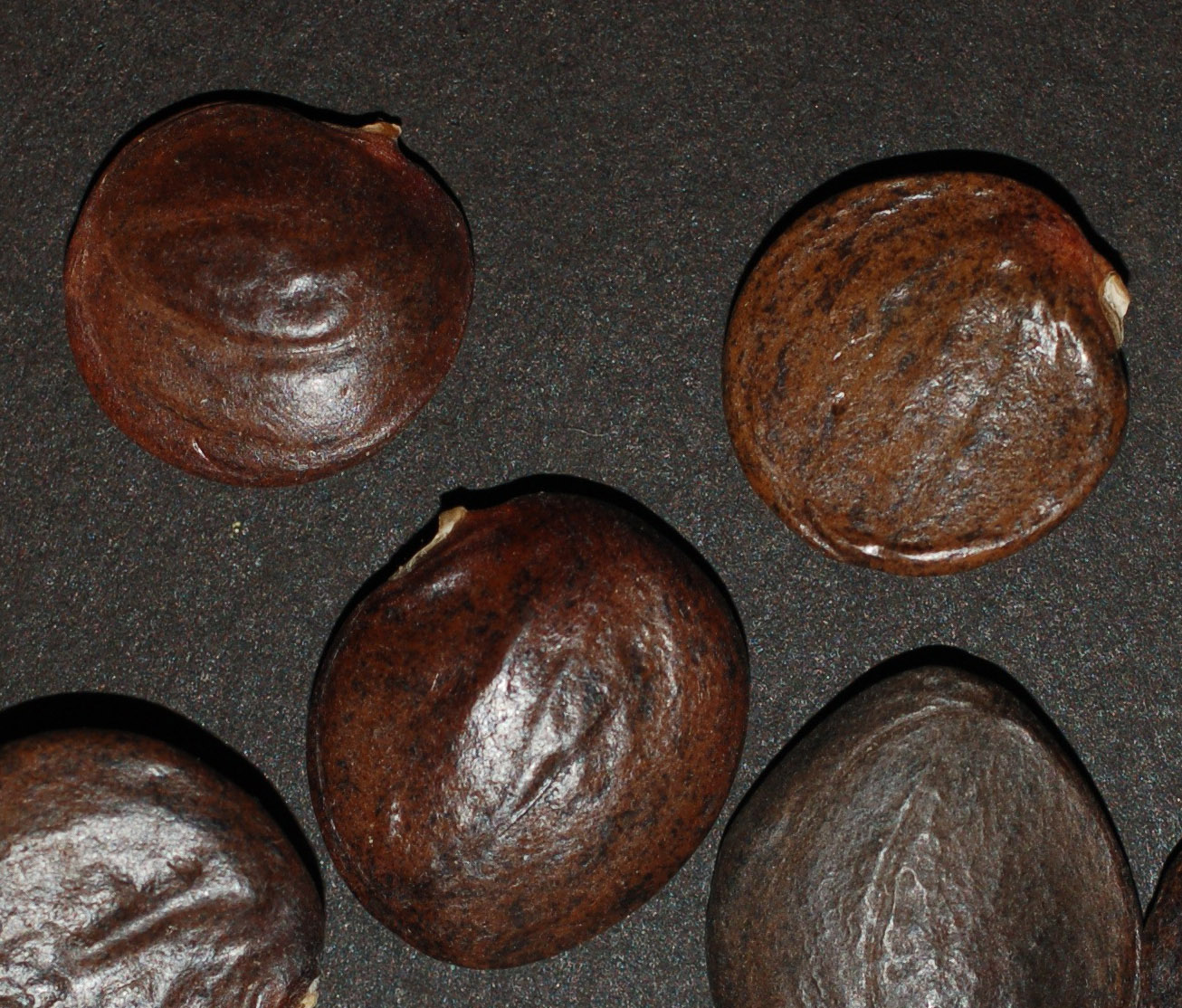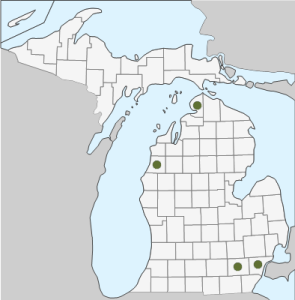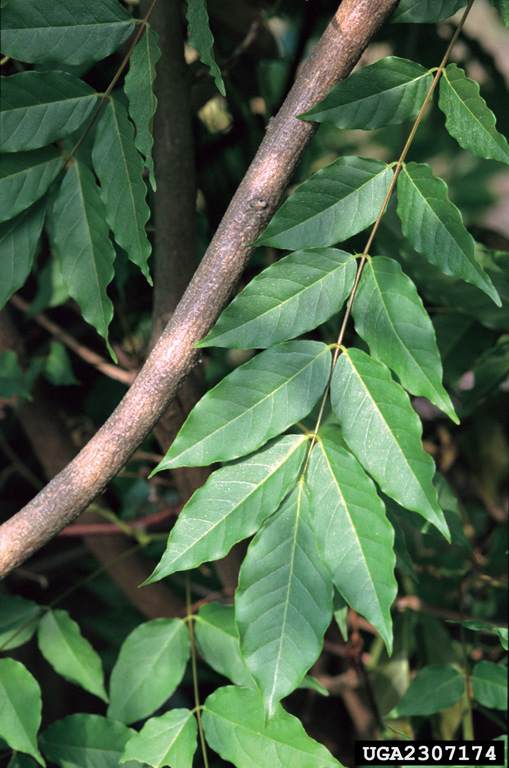 Download PDF
Download PDF
Name: Wisteria sinensis (Sims) DC.
 Family: Fabaceae (the pea family)
Family: Fabaceae (the pea family)
Common Names: Chinese Wisteria (1)
Etymology: Wisteria comes from Wistaria, an outdated and unused name for the genus. Wistaria was named by Thomas Nutall for Caspar Wistar, an American physician and anatomist (13). No information was found for sinensis, but presumably, it is the Latinized chinensis (Chinese).
Botanical synonyms:
Rehsonia sinensis (Sims.) Stritch (3)
Glycine sinensis – Sims. (4)
Wisteria chinensis – DC. (4)
Quick Notable Features:
¬ Thick woody vines, the bark with conspicuous white splotches
¬ Two petals of the corolla connate and boat-shaped, the others either large forming a banner, or lateral enclosing the “boat” petals
¬ Large, pendulous, many-flowered purple racemes
Plant Height: Stems can be up to 30 m in length (especially in mild climates), and will scale trees up to 30 m. It is thought that the height of W. sinensis is actually limited by that of the tree (2, 12).
 Subspecies/varieties recognized: none found
Subspecies/varieties recognized: none found
Most Likely Confused with: Wisteria frutescens, Wisteria floribunda, or Apios americana.
Habitat Preference: W. sinensis prefers full sunlight, but can grow in partial shade. It prefers well-drained loams. It is common along roadsides and forest edges (1).
Geographic Distribution in Michigan: Originally reported only in Emmet County (8, 11), but recent reports from three additional counties: Manistee, Washtenaw, and Wayne (15).
Known Elevational Distribution: Noted to grow up to elevations of 3500m in the Andes of Bolivia (7).
Complete Geographic Distribution: Native to Asia, W. sinensis was introduced to the U.S. in the early 1800s. It is now found in AL, AR, CT, FL, GA, IL, IA, KY, LA, MD, MA, MI, MS, NY, NC, PA, SC, TN, TX, VT, VA, WV, and Washington, D.C.
Vegetative Plant Description: This perennial plant has woody stems, each growing to 1m in diameter. The bark is brown with distinct white splotches. At each leaf node, there is a stipule approximately 5mm long; it sheds in the early stages of the leaf/stem development. The leaves are pinnately compound, up to 25cm long, and arranged alternately along the stem. They are 23-26cm long and 7-11cm wide, borne on a 3-5cm long petiole. Each leaf has 7-13 obovate to ovate leaflets (including a terminal leaflet). The leaflets are arranged oppositely along the rachis; they have wavy, entire margins and acuminate tips (2, 3, 5). Each leaflet is 3-7.5cm long and 2.1-3.3cm wide. Petiolules are 2-3mm long. The young leaflets are densely pubescent, but are glabrous to short-pubescent when mature (2, 3, 4, 5, 6, 7, 13).
Climbing Mechanism: W. sinensis climbs sinistrally, with its stem apex (1). Note that sinistral climbing is relatively rare among flowering plant species, and the closely related W. floribunda twines dextrally!
Flower Description: The flowers are blue, purple, light pink or white and borne in a pendulous raceme. This raceme can be more than 30 cm long, although it is usually 15-20cm long and 8-10cm in diameter. The flower is 5-merous and perfect, borne on a 1.8-2mm long pedicel. The calyx is 5mm in diameter and densely pubescent with unequal sepals. The calyx is bilabiate (bilaterally symmetrical). The tube of the flower is 3 mm long and nearly that broad. The petals are 2.3-2.6cm long and often have a yellow crest near the base. “Wing petals”, that is, the lateral petals in the flower, are clawed and have a triangular auricle at their base, 0.8-1mm long. The ovary is superior, finely pubescent, and supported by a stipe. The flower has ten stamens, nine of which are united by their filaments, the remaining stamen free (3, 5, 7, 10, 13).
Flowering Time: In Illinois, it flowers from April to May. The flowers toward the top of the raceme will open first (3, 13). It should be noted that “Wisterias often disappoint by not flowering for many years” (12). When they do flower, it is “before the leaves are fully expanded” (10). In severe climates, the buds may be killed by winter cold. In this case, Wisteria will produce a much-reduced crop of flowers in late summer on the year’s new growth (12).
Pollinator: In Michigan all individuals of W. sinensis may be sterile (11).
Fruit Type and Description: The fruit is a finely pubescent striated brown legume, 10-15cm in length, narrow near the base with some constrictions and two to four seeds per fruit (2, 6). 
Seed Description: The seed is orbicular and 10-15mm in diameter. It is unwinged and has a subapical funicular attachment. The seed surface is glabrous and slightly wrinkled (6).
Dispersal Syndrome: “In allextant species of Wisteria,the mature fruits burstopen explosively, expelling theseeds” (6). However, the seed is unwinged and glabrous, so it is unlikely that dispersal is subsequently aided by wind. Vegetative reproduction is the main reproductive method of W. sinensis. Stolons develop roots and facilitate vegetative propagation (2, 6,12).
 Distinguished by: According to Voss (11), the petioles and petiolules of W. sinensis are a bit longer than those of W. frutescens. Furthermore, W. frutescens has a glabrous ovary and glabrous fruits, as well as club-shaped glands on its pedicels and calyx. W. floribunda may be distinguished by its leaflets: there are more per petiole, and young leaves are reddish. The bark of W. floribunda is more of a chalky gray. The most obvious difference, however, is that while W. sinensis twines dextrally, W. floribunda twines sinistrally. Apios americana may be differentiated from Wisteria by its pubescent petioles and leaf veins (it is pubescent on both top and bottom). Furthermore, the completely herbaceous Apios usually has cream-colored flowers.
Distinguished by: According to Voss (11), the petioles and petiolules of W. sinensis are a bit longer than those of W. frutescens. Furthermore, W. frutescens has a glabrous ovary and glabrous fruits, as well as club-shaped glands on its pedicels and calyx. W. floribunda may be distinguished by its leaflets: there are more per petiole, and young leaves are reddish. The bark of W. floribunda is more of a chalky gray. The most obvious difference, however, is that while W. sinensis twines dextrally, W. floribunda twines sinistrally. Apios americana may be differentiated from Wisteria by its pubescent petioles and leaf veins (it is pubescent on both top and bottom). Furthermore, the completely herbaceous Apios usually has cream-colored flowers.
Other members of the family in Michigan [number species]: Wisteria (1), Amorpha (2), Amphicarpaea (1), Anthyllis (1), Apios (1), Astragalus (3), Baptisia (4), Caragana (1), Cercis (1), Chamaecrista (2), Cladrastis (1), Colutea (1), Crotalaria (1), Cytisus (1), Dalea (1), Desmodium (12), Genista (1), Gleditsia (1), Glycine (1), Gymnocladus (1), Hedysarum (1), Kummerowia (1), Lathyrus (10), Lespedeza (13), Lotus (1), Lupinus (2), Melilotus (2), Mimosa (1), Orbexilum (1), Phaseolus (2), Pisum (1), Pueraria (1), Robinia (3), Securigera (1), Senna (1), Strophostyles (1), Tephrosia (1), Trifolium (9), Vicia (8), Vigna (1) [8].
Ethnobotanical Uses: The raw seeds of all Wisteria are poisonous. When cooked, however, the seed can be eaten. The flowers can be cooked and made into fritters. They can also be made into a tea. A fiber from the stem has been used in papermaking (4).
 Phylogenetic Information: The Fabaceae is the primary family in the order Fabales, making up a majority of the species. Within the Fabales, Fabaceae is closely related to Polygalaceae and more distantly related to Quillajaceae and Surianaceae. The Fabales, Rosales, Cucurbitales, and Fagales are closely related within the Eurosids I, and a notable characteristic of the species within these orders is their ability to fix nitrogen. The Eurosids I are within the Eudicots clade.
Phylogenetic Information: The Fabaceae is the primary family in the order Fabales, making up a majority of the species. Within the Fabales, Fabaceae is closely related to Polygalaceae and more distantly related to Quillajaceae and Surianaceae. The Fabales, Rosales, Cucurbitales, and Fagales are closely related within the Eurosids I, and a notable characteristic of the species within these orders is their ability to fix nitrogen. The Eurosids I are within the Eudicots clade.
There is also weak support for a relation between Fabaceae and Zygophyllaceae, a family in the Zygophyllales, which is in turn within the Eurosids I (9).
Interesting Quotation or Other Interesting Factoid not inserted above:
– Wisteria vines can live > 50 years and destroy sizable areas of forest. The stems strangle native shrubs and trees, and in killing them, open up the canopy and allow more light to the forest floor. This favors the aggressive nature of the plant, which can form thickets “so dense that little else grows” (1).
– Recent molecular genetic studies indicate that W. sinensis has a high probability of hybridizing with not only the Japanese Wisteria (W. floribunda), but also native species (14).
– Like most other members of Fabaceae, Wisteria is nitrogen-fixing (9).
Literature and websites cited:
- USDA’s Weed of the Week, 2004-2007. Last modified: February 2006. http://www.na.fs.fed.us/fhp/invasive_plants/weeds/exotic-wisterias.pdf
- http://www.nps.gov/plants/alien/fact/wist1.htm
- Iverson, L.R., D. Ketzner, and J. Karnes. 1999 – 2007. Illinois Plant Information Network: Illinois Natural History Survey & USDA Forest Service. http://www.fs.fed.us/ne/delaware/ilpin/ilpin.html.
- Plants For A Future, 1996-2003. Last modified: June 2004. http://www.pfaf.org/database/plants.php?Wisteria+sinensis
- http://www.texasinvasives.org/Invasives_Database/Results/Detail.asp?Symbol=WISI
- Wang, Q., D.L. Dilcher, X.Y. Zhu, L.Y. Zhou, and T.A. Lott 2006. Fruits and leaflets of Wisteria (Leguminosae, Papilionoideae) from the Miocene of Shandong Province, eastern China. International Journal of Plant Sciences 167(5):1061-1074.
- MOBOT’s eFlora’s website. http://www.efloras.org/florataxon.aspx?flora_id=5&taxon_id=200012368
- The PLANTS Database: USDA, NRCS, 1991-2007. http://plants.usda.gov/java/profile?symbol=WISI
- Stevens, P.F. 2001- 2006. Angiosperm Phylogeny Website, Last modified: January 2007. http://www.mobot.org/MOBOT/research/APweb/
- Gleason, H.A. 1963. Illustrated Flora of the Northeastern United States and Adjacent Canada. New York City, New York, USA: The New York Botanical Garden.
- Voss, E.G. 1996. Michigan Flora: Dicots Concluded. Cranbrook Institute of Science: Bloomfield Hills, Michigan.
- Seymour, E.L.D. 1946. The New Garden Encyclopedia. New York City, New York, USA: WM. H Wise & Co., Inc.
- Radford, A.E., H.E. Ahles, and C.R. Bell. 1968. Manual of the Vascular Flora of the Carolinas. Chapel Hill, North Carolina, USA: The University of North Carolina Press.
- Trusty, J.L., B.G. Lockaby, W.C. Zipperer and L.R. Goertzen 2008. Horticulture, hybrid cultivars and exotic plant invasion: a case study of Wisteria (Fabaceae). Botanical Journal of the Linnean Society 158:593-601.
- Michigan Flora Online. A.A. Reznicek, E.G. Voss, & B.S. Walters. February 2011. University of Michigan. Web. February 7, 2014. http://michiganflora.net/species.aspx?id=1370.
Image Credits (all used with permission):
1) Tree with twining stem: copyright Chris Evans, River to River CWMA, Bugwood.org. UGA 1380453
2) Plant in flower: copyright Chris Evans, River to River CWMA, Bugwood.org. UGA 2188059
3) Image of leaves copyright James H. Miller, USDA Forest Service, United States. UGA UGA 2307174
4) Image of flower close-up copyright Chris Evans, River to River CWMA, Bugwood.org. UGA 1119501 (annotation by Plant Diversity Website)
5) The image of the seeds is copyright Robyn J. Burnham, University of Michigan
6) The image of the fruits and seeds is courtesy Ted Bodner @ USDA-NRCS PLANTS Database / Miller, J.H. and K.V. Miller. 2005. Forest plants of the southeast and their wildlife uses. University of Georgia Press, Athens.
7) Species distribution map, derived from the Michigan Flora Online.
Primary Author: ReBecca Sonday with final editing by John Bradtke and Robyn J. Burnham
© Robyn J. Burnham, University of Michigan
For additional information on Michigan Plant Diversity web pages please contact Robyn J. Burnham via email: rburnham“at”umich.edu
